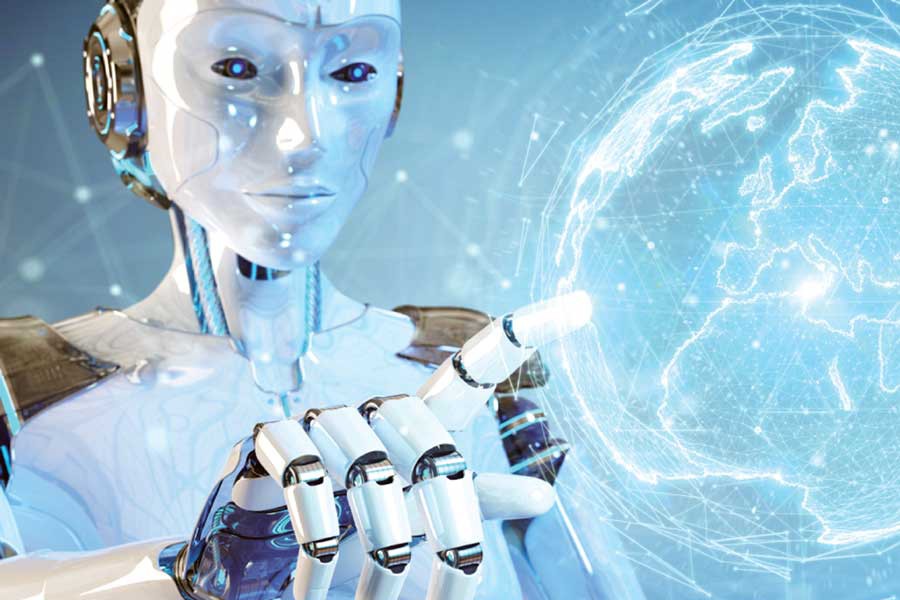
Promise and potential perils of 4th Industrial Revolution
Masum Billah | Wednesday, 13 November 2019

 The world stands on the cusp of the Fourth Industrial Revolution, different from thre previous three. It talks about exponential changes due to adoption of cyber-physical systems, and Internet of things and systems. This revolution is expected to impact all disciplines, industries, and economies.
The world stands on the cusp of the Fourth Industrial Revolution, different from thre previous three. It talks about exponential changes due to adoption of cyber-physical systems, and Internet of things and systems. This revolution is expected to impact all disciplines, industries, and economies.
Professor Klaus Schwab, founder and executive chairman of the World Economic Forum (WEF), says, "The changes are so profound that, from the perspective of human history, there has never been a time of greater promise or potential peril. My concern, however, is that decision-makers are too often caught in traditional, and non-disruptive thinking or too absorbed by immediate concerns to think strategically about the forces of disruption and innovation shaping our future."
Developments in the fields of artificial intelligence, machine learning, sensor technologies, automation, robotics, biotechnologies, nanotechnologies, data analytics, autonomous systems, decentralised operations, and data ownership are some areas that are likely to advance and experience significant growth. The Fourth Industrial Revolution literally represents a fundamental change in the way we live, work and relate to one another. It is a new chapter in human development, enabled by extraordinary technology advances commensurate with those of the first, second and third industrial revolutions.
These advances are merging physical, digital and biological worlds in ways that create both huge promise and potential peril. Speed, breadth and depth of this revolution are forcing us to rethink how countries develop, how organisations create value and even what it means to be human beings.
It is about more than just technology-driven change; it is an opportunity to help everyone, including leaders, policymakers and people from all income groups and nations, to harness converging technologies in order to create an inclusive, human-centred future. The real opportunity is to look beyond technology, and find ways to give the greatest number of people the ability to positively impact their families, organisations and communities.
The first industrial revolution, in the 18th and 19th centuries, involved a change from mostly agrarian societies to greater industrialisation as a consequence of the steam engine and other technological developments. The Second Industrial Revolution occurred between the end of the 19th century and the first two decades of the 20th century and it brought major breakthroughs in the form of electricity distribution, both wireless and wired communication, the synthesis of ammonia and new forms of power generation. The Third Industrial Revolution began in the 1950s with the development of digital systems, communication and rapid advances in computing power, which have enabled new ways of generating, processing and sharing information.
The Fourth Industrial Revolution can be described as the advent of "cyber-physical systems" involving entirely new capabilities for people and machines. According to Professor Klaus Schwab, who authored the book, The Fourth Industrial Revolution, the new age is differentiated by the speed of technological breakthroughs, the pervasiveness of scope and the tremendous impact of new systems. In the future, it can also change the things we value and the way we value them. It can change our relationships, our opportunities, and our identities as it changes the physical and virtual worlds we inhabit.
What it promises
It is to improve quality of life for the world's population and raise income levels. The ones in the developed world are already enjoying some benefits. Our workplaces and organisations are becoming "smarter" and more efficient as machines, and humans start to work together. The social media revolution has given everyone some voice and a way to communicate instantly. Today, more than 30 per cent of \the world's population use social media services.
Advances in automotive safety through Fourth Industrial Revolution technologies may reduce road fatalities and insurance costs, and carbon emissions. Autonomous vehicles can reshape the living spaces of cities, architecture, and roads themselves, and free up space for more social and human-centred spaces. Organising transport, booking restaurants, buying groceries and other goods, making payments, listening to music, reading books or watching films - these tasks can now be done instantly.
Education and access to information can improve the lives of billions. Through increasingly powerful computing devices and networks, digital services, and mobile devices can become a reality for people around the world. These innovations can give people opportunities to learn and earn in new ways, and they can give people new identities as they see potential for themselves.
In a 2016 article, Schwab wrote, "In the future, technological innovation will also lead to a supply-side miracle, with long-term gains in efficiency and productivity. Transportation and communication costs will drop, logistics and global supply chains will become more effective, and the cost of trade will diminish, all of which will open new markets and drive economic growth."
Digital technology can liberate workers from automatable tasks, freeing them to concentrate on addressing more complex business issues and giving them more autonomy. It can also provide workers with radically new tools and insights to design more creative solutions to previously insurmountable problems. Technological advances are also broadening the scope of surveillance. In the UK today, an estimated six (6) million CCTV cameras are recording activity. Advances in computing power and artificial intelligence can potentially enable law enforcement agencies to track suspected terrorists by analysing social networks, government records, and other data.
In the future, billions of 3D-printed "smart dust" cameras floating in the air can monitor the activities of humans. Just as the Internet did 20 years ago, the artificial intelligence revolution is going to transform many jobs.
The Fourth Industrial Revolution coincides with the period when Bangladesh transitions towards a developed country. By 2030, around half of Bangladesh people will be living in urban areas. These people will demand all kinds of goods and services that we cannot predict today.
And potential perils
Technologies can bring negative results if we don't think about how they can change us. There might be increased social tensions as a result of the socioeconomic changes brought by the Fourth Industrial Revolution. It could create a job market that is segregated into "low-skill or low-pay" and "high-skill or high-pay" segments. Some jobs will become obsolete.
The changes might take place so swiftly, that even those who are ahead of the curve in terms of their knowledge and preparation, might not be able to keep up with the ripple effects of the changes. Artificial intelligence, robotics, bioengineering, programming tools, and other technologies can all be used to create and deploy weapons to kill humans.
Social media can erase borders and bring people together, but it also can intensify the social divide. And it gives voice to cyber-bullying, hate speech, and spreading false stories. It can be a disruptive force, dislocating people from jobs and surfacing questions about relationship between humans and machines. Powerful new technologies built on global digital networks can be used to keep societies under undue surveillance while making us vulnerable to physical and cyber-attacks.
Today, economic benefits of the Fourth Industrial Revolution are becoming more concentrated within a small group. This increasing inequality can lead to political polarisation, social fragmentation, and lack of trust in institutions.
Authors of shaping the Fourth Industrial Revolution point out, at least 600 million people live on smallholder farms without access to any mechanisation, living lives largely untouched by the first industrial revolution. Around one-third of the world's population (2.4 billion) lack clean drinking water and safe sanitation, around one-sixth (1.2 billion) have no electricity - both systems developed in the second industrial revolution.
And while the digital revolution means that more than 3 billion people now have access to the Internet, that still leaves more than 4 billion out of a core aspect of the third industrial revolution. From traffic reports to natural disasters, such technology can keep us safer. But it also can watch us when we do not want to be watched. Public trust in business, government, the media, and even technology is falling. This is a crisis that is dividing societies and creating instability around the world.
The WEF predicted that about 800 million people worldwide could lose their jobs by 2030, while approximately 5.7 million unskilled Bangladeshis would be sacked from their jobs abroad and at home due to a lack of technological skills. For example, in 2013, the RMG sector employed about 4.4 million workers in Bangladesh, a figure that dropped significantly to about 3.5 million by 2018. It is argued that one machine can potentially lay off 10 workers. So, the scenario calls for judicious and timely steps to be taken by the country's policymakers to cope with the Fourth Industrial Revolution
Conclusion
It, finally, will change not only what we do but also who we are. It will affect our identity and all the issues associated with it: our sense of privacy, our notions of ownership, our consumption patterns, the time we devote to work and leisure, and how we develop our careers, cultivate our skills, meet people, and nurture relationships. Artificial intelligence (AI) describes computers that can "think" like humans - recognising complex patterns, processing information, drawing conclusions, and making recommendations. Biotechnology harnesses cellular and bimolecular processes to develop new technologies and products for a range of uses, including developing new pharmaceuticals and materials, more efficient industrial manufacturing processes, and cleaner, more efficient energy sources. Robotics refers to design, manufacture, and use of robots for personal and commercial use.
It's beyond doubt that education is at the heart of preparing present and future generations to thrive. As a result it's vital that we have an education that develops human potential rather than pits it against machines. This won't be easy given the perverse financial incentives of an education model rooted in the late 19th century, driven by an antiquated text book and measurement industry that regards teaching as delivery rather than design.
For decades this industry would mean that human teachers could eventually be replaced by computers. But this has distorted the nature of teaching and learning which is a uniquely personal and social activity between people that caters to every learner's changing needs, unique talents, passions, and interests. In fact the very things that set them aside from the machines are now emerging as part of this next industrial revolution.
.........................................................
Masum Billah is Programme Manager at BRAC Education Programme and Vice-President at Bangladesh English Language Teachers Association (BELTA).
masumbillah65@gmail.com